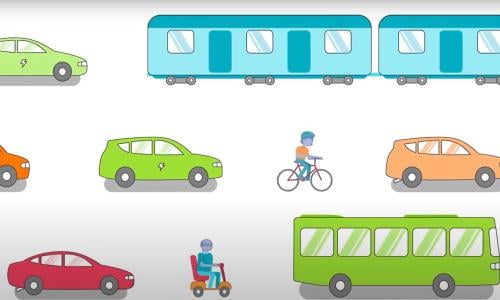Table of Contents
Did the report consider other air pollution, besides global warming emissions, from electric vehicles?
Our analysis focused on global warming emissions from operating an electric vehicle and the costs of charging. Other analyses have looked at the air quality implications of electric vehicles.
A 2007 report by the Natural Resources Defense Council and the Electric Power Research Institute is one of the most comprehensive analyses done to date. The study looks at projections of plug-in electric vehicles over time and the change in ozone concentrations and other pollutants that might be expected and finds that the vast majority of areas will see improved air quality.
Air quality analyses require sophisticated modeling to perform because the location and timing of the emissions are important factors in determining changes in air pollutions concentrations and the resulting population exposures to these pollutants.
A move towards more renewables and away from coal will reduce other air pollutants in addition to global warming emissions, and ensure electric vehicles deliver the greatest benefits.
Are the mpg values used in the study real-world or are they based on compliance data for federal fuel economy and greenhouse gas emissions?
Our mpg ratings are based on the combined city/highway fuel economy window sticker values, like those found on the www.fueleconomy.gov website. These values much more closely reflect real world driving than the mpg values used to determine compliance with federal fuel economy standards. For more information on how mpg ratings differ for compliance testing and window labels, see our fact sheet about translating standards into on-road fuel efficiency.
If you are charging a electric vehicle overnight, are you using electricity that would be wasted anyway?
There is typically excess electricity generating capacity overnight because electricity demand is lower than peak times which typically occur during the day. However, electricity production continually changes to match demand. Power plants that are not needed at night are shutdown or their output is reduced to match demand during these periods. In other words, electricity is not being wasted. In some rare cases, wind power has been curtailed, or shut off, because of too much electricity on the grid. This happened recently in the northwest when large river flows and windy conditions created excess electricity production, but is not a common occurrence.
Has the electricity grid been getting cleaner since 2007, and does that impact the results of the report?
In recent years, generation of coal-powered electricity has declined while natural gas and renewables has increased. As a result newer power plant data is expected to show that EVs powered by the electricity grid have even lower emissions. This trend is expected to continue into the future in part due to state renewable energy standards, 30 of which exist across the country, and the retirement of older, less efficient coal-fired plants. As a result, an EV bought today will get cleaner the longer you own it.
As new data becomes available, we will update our analysis to reflect the changing grid mix.
New electricity users vs old users: Does State of Charge treat them equally?
Our approach to estimating emissions treats all users of a region’s electricity equally, meaning no matter what device is using the electricity, be it a ten-year old hot tub or a brand new Nissan LEAF, each kWh of electricity they consume is presumed to have the same emissions.
An alternative approach is to use marginal emissions, which represent the additional emissions that are expected by adding a new electricity load to the grid. For example, plugging in your new EV means a power plant somewhere has to increase its output just a little bit. If that power plant happens to be coal fired, the emissions from charging your EV would be equivalent to about a 30 mpg gasoline vehicle. If it just so happens that excess wind generation is on the grid (the rare occurrence noted above) then you could claim your EV would have zero emissions.
Marginal emission analysis is important for understanding the impact of thousands of vehicles plugging in the electricity grid, or any new demand on the electricity grid for that matter. But for an individual consumer, treating all the electrons coming into your house the same, whether they are powering up your old hot tub, charging your new EV, or powering that new flat screen TV, makes the most sense.
Think about how a marginal type of analysis might play out if applied to gasoline. Oil from tar sands for example, a growing source of oil, has higher emissions because of the greater energy required for extraction.
So you pull up to the gas station in your new Chevy Volt, the first car you have ever owned, and someone next to you is filling up a 1986 Dodge Ram pickup. You want to know the global warming emissions that will result from consuming the gallon of gasoline each of you is putting in the tank. Does the gallon of gasoline going into the new Volt contain more, less, or the same amount of carbon as the gallon of gasoline going in to the old pick-up? Using average emissions – they are equal. Using marginal emissions – they are different.
Our collective decisions to use gasoline and electricity contribute to the resulting emissions from these sources of energy. Marginal emissions analysis is key to understanding the emissions impact of these decisions on a large scale and into the future. But using the average emissions of gasoline and electricity to understand the carbon footprint of individual vehicle choices, as we do in our analysis, provides a reasonable estimate for an individual.
What data was used to estimate electric vehicle emissions?
The data used to estimate the emissions from power plants is based on data compiled by EPA in their eGrid database. The most recent available version was used, which includes emissions data from plants operating in 2007. We also included the emissions from extraction and transportation emissions of energy sources used in electricity production. For example, the emissions from coal mining and transporting the coal to the power plant are included, as well as the inefficiencies of getting electricity from the power plant to your house. We treated gasoline in a similar manner, accounting for the extraction, refining and transportation of gasoline.
We used Argonne National Labs GREET model to determine the emissions from producing and burning a gallon of gasoline as well as for the upstream electricity generation feedstock emissions described above.
**Answers by report lead author Don Anair, senior analyst/engineer.



